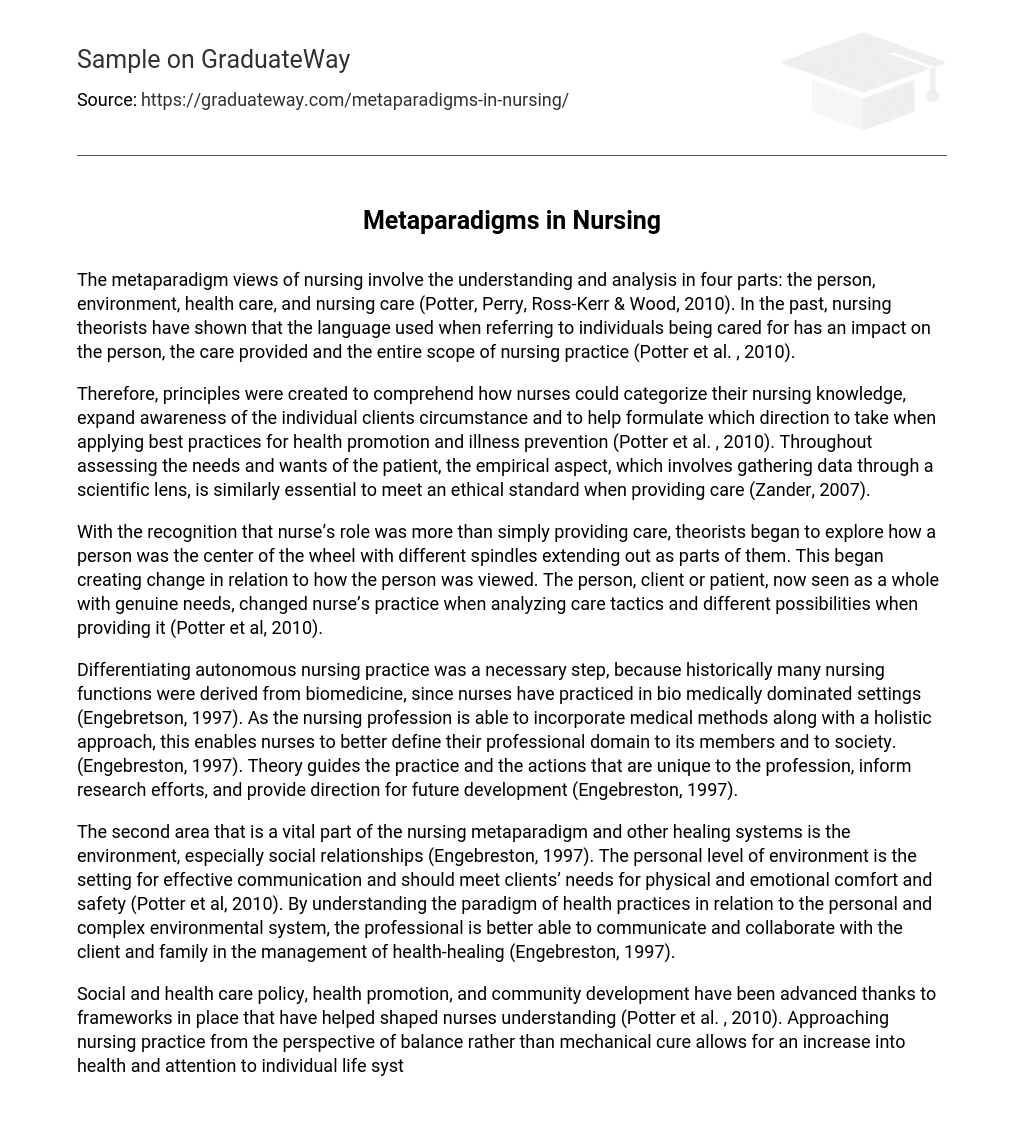The metaparadigm views of nursing involve the understanding and analysis in four parts: the person, environment, health care, and nursing care (Potter, Perry, Ross-Kerr & Wood, 2010). In the past, nursing theorists have shown that the language used when referring to individuals being cared for has an impact on the person, the care provided and the entire scope of nursing practice (Potter et al. , 2010).
Therefore, principles were created to comprehend how nurses could categorize their nursing knowledge, expand awareness of the individual clients circumstance and to help formulate which direction to take when applying best practices for health promotion and illness prevention (Potter et al. , 2010). Throughout assessing the needs and wants of the patient, the empirical aspect, which involves gathering data through a scientific lens, is similarly essential to meet an ethical standard when providing care (Zander, 2007).
With the recognition that nurse’s role was more than simply providing care, theorists began to explore how a person was the center of the wheel with different spindles extending out as parts of them. This began creating change in relation to how the person was viewed. The person, client or patient, now seen as a whole with genuine needs, changed nurse’s practice when analyzing care tactics and different possibilities when providing it (Potter et al, 2010).
Differentiating autonomous nursing practice was a necessary step, because historically many nursing functions were derived from biomedicine, since nurses have practiced in bio medically dominated settings (Engebretson, 1997). As the nursing profession is able to incorporate medical methods along with a holistic approach, this enables nurses to better define their professional domain to its members and to society. (Engebreston, 1997). Theory guides the practice and the actions that are unique to the profession, inform research efforts, and provide direction for future development (Engebreston, 1997).
The second area that is a vital part of the nursing metaparadigm and other healing systems is the environment, especially social relationships (Engebreston, 1997). The personal level of environment is the setting for effective communication and should meet clients’ needs for physical and emotional comfort and safety (Potter et al, 2010). By understanding the paradigm of health practices in relation to the personal and complex environmental system, the professional is better able to communicate and collaborate with the client and family in the management of health-healing (Engebreston, 1997).
Social and health care policy, health promotion, and community development have been advanced thanks to frameworks in place that have helped shaped nurses understanding (Potter et al. , 2010). Approaching nursing practice from the perspective of balance rather than mechanical cure allows for an increase into health and attention to individual life systems (Engebreston, 1997). Although biomedicine and the holistic approach are distinguished and accepted as separate practices, it is ideal to have the two aligned to have nursing practice be healing (Engebreston, 2007). Health is a derivative of healing, or making whole, and part of the metaparadigm of nursing ” (Engebreston, 1997). It has become evident through the presenting paper that many theories and frameworks all contribute in an influencing way on nursing practice. Evidently a key point through each concept is the value held in understanding and building relationships with clients and caregivers to implement best practices. Engaging in relationships and assessing the individual needs, has become well defined as an important piece within the planning process for health needs and goals.
Additionally recognized is the importance of individualizing each person and corresponding accordingly to his or her personality traits, as it has become a significant part of nursing practice. References Engebretson, J. (2007). A Multiparadigm Approach to Nursing. Advances in Nursing Science, 20(1), 21-33. Retrieved from http://ovidsp. tx. ovid. com/sp-3. 8. 0b/ovidweb. cgi? T=JS&PAGE=fulltext&D=ovft&AN=00012272-199709000-00005&NEWS=N&CSC=Y&CHANNEL=PubMed McCrae, N. (2012). Whither Nursing Models? The value of nursing theory in the context of evidence-based practice and multidisciplinary health care.
Journal Of Advanced Nursing, 68(1), 222-229. doi:10. 1111/j. 1365-2648. 2011. 05821. x Thorne, S. (2010). Theoretical Foundations of Nursing Practice. In Ross-Kerr, J. C. & Wood, M. J. (4th Ed. ), Canadian Fundamentals of Nursing (pp. 66-67). Toronto: Elsevier Canada. Zander, P. , (2007). Ways of knowing in nursing: the historical evolution of a concept. Journal of Theory Construction & Testing, 11(1), 7-11. Retieved from: http://web. ebscohost. com. exproxy. viu. ca/ehost/detail? vid=122&hid=f593f394-599a-414b-8074-109f7b9527e5%40sessionmgr15&bdata=JkF1dGhUeXB1PW1wLGNvb2tpZSZzaXR1PWVob3NOLWxpdmU%3d#db=c8h&AN=2009612639





